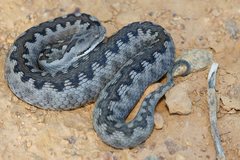Iberian wall lizard
Podarcis hispanicus
Podarcis hispanicus is a species of lizard belonging to the family Lacertidae, commonly known as the Spanish wall lizard, or in Spanish, the "lagartija ibérica." This species is a prominent reptile in the Comunidad Valenciana and can be found throughout various habitats in the region.
Key Characteristics:
- Appearance: These lizards have a slender body and long tails, typically measuring between 12 to 20 cm in total length. Their coloration can vary significantly but usually consists of a green, brown, or greyish background with darker and lighter spots and patterns that often serve as camouflage against predators.
- Habitat: Podarcis hispanicus thrives in a variety of habitats, including rocky landscapes, sand dunes, and rural gardens. They are adaptable and can often be seen basking in the sun on walls, fences, and other man-made structures.
- Diet: These lizards are insectivorous, primarily feeding on a diet of small insects and arthropods. They are active hunters, often seen darting quickly to capture prey.
- Behavior: Known for their agility, the Spanish wall lizard is a fast runner, often using its speed to escape from predators. During the warmer months, they are most active during the day.
- Reproduction: Breeding occurs in the spring, with females laying several small clutches of eggs throughout the summer. Juvenile lizards typically hatch after a few weeks and are independent from birth.
The Podarcis hispanicus plays a crucial role in local ecosystems as both predator and prey, contributing to the biodiversity of the Comunidad Valenciana. Its presence is an indicator of healthy ecosystem dynamics where it thrives.






